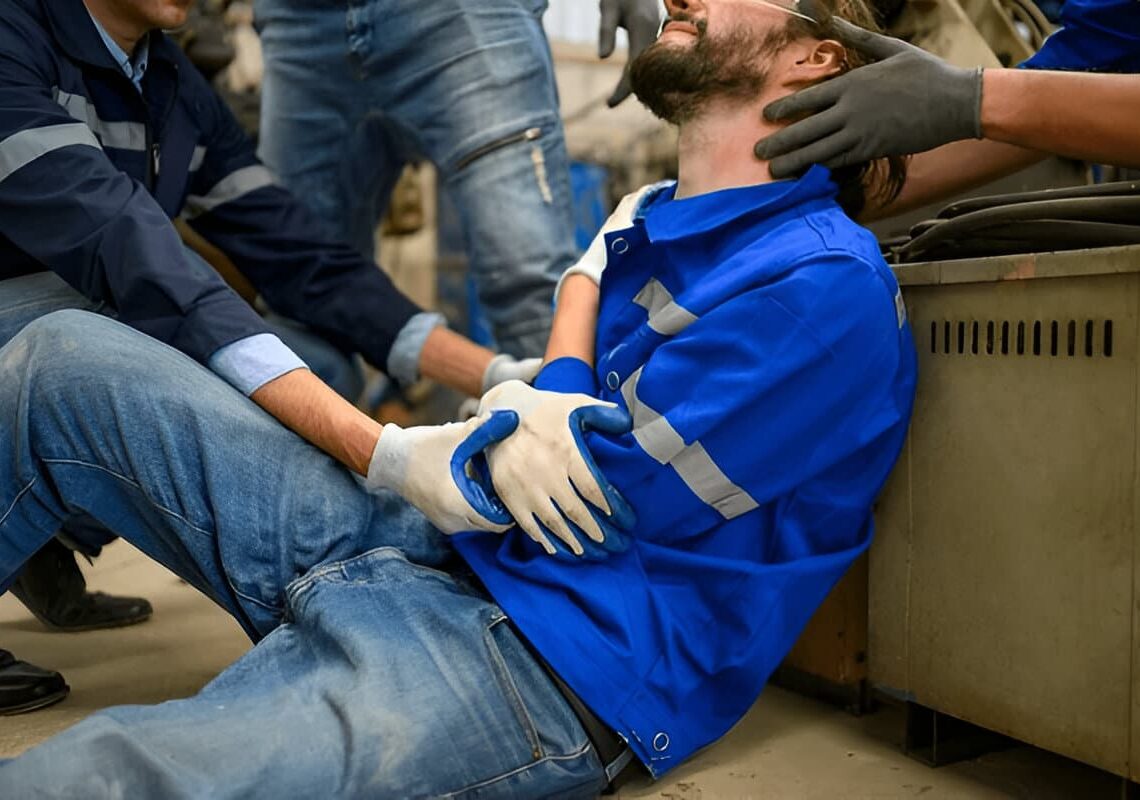Who Is Liable for Warehouse Accidents in Indiana?

After a warehouse accident in Indiana, injured workers typically have two potential paths for financial recovery.
The first is a workers’ compensation claim against your employer, which is a no-fault system designed to cover medical bills and a portion of lost wages, regardless of who caused the accident.
The second is a third-party liability claim, which is a personal injury lawsuit filed against a negligent non-employer, such as an equipment manufacturer or a separate contractor. This claim allows you to pursue damages not available through workers’ comp, like pain and suffering.
An experienced warehouse accidents lawyer can help you determine if you may pursue one or both of these options.
Key Points About Indiana Warehouse Accident Liability
- Employers: Typically liable through the no-fault workers’ compensation system.
- Third Parties: Equipment manufacturers, maintenance companies, or property owners can be sued for negligence.
- Your Rights: You have the right to medical treatment and wage replacement benefits under workers’ comp.
- Evidence is Crucial: Documenting the scene, your injuries, and witnesses can improve the outcome of any claim.
Types of Warehouse Accidents in Indiana and Who May Be Liable For Them
Warehouse accidents in Indiana can lead to serious injuries. Understanding the different types listed below is essential to determining liability.
Forklift Accidents
According to OSHA, forklift violations rank as one of the top-cited safety failures in warehouses across the USA, emphasizing the need for proper oversight and adherence to safety standards. Key factors contributing to forklift warehouse accidents in Indiana include:
- Poorly trained operators lacking certification or safety knowledge.
- Faulty or uninspected forklift brakes, leading to collisions or loss of control.
- Obstructed paths, where tight spaces contribute to tip-overs or worker injuries.
- Overloading of forklifts, causing instability and potentially crushing bystanders.
OSHA regulations (29 CFR 1910.178) require employers to ensure all operators are adequately trained and their equipment is regularly inspected. Failure in these areas can make employers or third-party maintenance providers liable for financial compensation for injuries that occur.
Falling Objects
OSHA regulations mandate secure stacking and storage practices to minimize these accidents. Yet, they remain among the most frequent causes of injury in warehouses. Specific examples include:
- Unsafely stacked inventory that collapses and hits workers below.
- Damaged or poorly assembled shelving systems that fail under pressure.
- Items falling during the use of lifting equipment, like forklifts or hoists.
- Lighting equipment or warehouse fixtures becoming dislodged and striking workers.
Liability for falling object cases often points to employers failing to enforce safety protocols or improper installation by third-party contractors. Showing proof of safety violations in these cases can establish responsibility and secure compensation for affected workers in third-party liability claims..
Slip and Fall Incidents
Slip and fall accidents remain a pressing issue in warehouses, typically caused by preventable hazards or lack of proper maintenance. Data from the National Safety Council highlights how slips and trips continue to be leading contributors to workplace injuries nationwide. Common causes in warehouse settings include:
- Spills or leaks from machinery that create slippery surfaces.
- Uneven flooring or unrepaired cracks, leading to tripping hazards.
- Obstructed walkways cluttered with tools, packaging, or debris.
- Failing to address weather-related hazards, like icy or wet entrances.
Under OSHA’s general duty clause, employers must keep the workplace free of recognized hazards, including maintaining a clean and safe environment. Neglecting these responsibilities can lead to liability, particularly in cases where multiple workers report similar safety concerns.
Pallet Rack Failures
Poor installation, misuse, or overloading are frequently cited as reasons behind pallet rack accidents. Examples of contributing factors include:
- Exceeding the weight capacity of shelves, causing structural failure.
- Improper assembly of racks, leaving them unstable or misaligned.
- Lack of regular inspections and maintenance checks to identify weakened components.
- Using damaged racking systems without replacing compromised parts.
Compliance with OSHA guidelines for safe stacking and storage can prevent pallet rack collapses. When employers or contractors fail to adhere to these standards, liability often falls on those responsible for ensuring safety and structural integrity within the facility.
Heavy Machinery Malfunctions
OSHA emphasizes the importance of machine safety through regulations like the Control of Hazardous Energy (29 CFR 1910.147), which require proper lockout-tagout procedures to prevent accidental activation. Examples of malfunctions include:
- Conveyor belts jamming and exposing workers to sharp components or trapped limbs.
- Presses or compactors engaging unexpectedly due to electrical failures.
- Hydraulic systems leaking or failing under pressure, leading to explosions or injuries.
- A lack of emergency stops or guardrails on active machinery.
The responsibility for safe machinery operation and maintenance typically falls on employers and contracted maintenance teams. Failure to comply with safety regulations is an actionable oversight that may establish liability during legal proceedings.
Hazardous Material Exposure
Without adequate safeguards, exposure to toxic chemicals or flammable substances can lead to severe health issues or immediate injuries. Compliance with OSHA’s Hazard Communication Standard (29 CFR 1910.1200) is mandatory for workplaces handling hazardous substances. Common risks include:
- Handling improperly labeled chemicals, leading to accidental exposure or misuse.
- Faulty containment systems resulting in leaks or spills of hazardous substances.
- Insufficient ventilation in areas storing flammable or volatile materials.
- Missing or inadequate protective gear, such as gloves or respirators.
Employers who fail to implement required safety measures, like training employees on hazardous material handling or ensuring proper labeling, risk legal liability for any resulting injuries or illnesses.
How To Demonstrate Liability in Indiana Warehouse Accidents?
Contact an Indian Workers’ Compensation Lawyer

Following a warehouse accident, contacting a lawyer is one of the most critical steps you can take to protect your rights. Their knowledge and experience can help evaluate liabilities, preserve evidence, and guide you through the complexities of workers’ compensation or additional claims. A lawyer can assist by:
- Conducting a thorough analysis to determine potential unsafe conditions or negligence.
- Ensuring key evidence, like photos or witness statements, is preserved for litigation.
- Advising on deadlines for filing claims to prevent forfeiting your rights.
- Identifying liable parties beyond your employer, such as third-party contractors or equipment manufacturers.
With a lawyer’s involvement, your case benefits from professional insight, which increases the likelihood of compensation that reflects the true scope of your injuries and damages.
Document the Scene of the Accident
Preserving evidence immediately following a warehouse accident is vital. Detailed documentation can support liability claims and give your lawyer a clearer picture of what occurred. Take steps like:
- Photographing the scene, including hazards like spills, damaged equipment, or collapsing racks.
- Capturing images of visible injuries and the specific location where the accident happened.
- Requesting access to security footage, if appropriate, that documents the incident.
- Retaining a copy of any accident report submitted to your employer or safety officer.
These details can be invaluable for building a strong case, ensuring no key elements of the accident are omitted.
Collect Witness Accounts
Eyewitness testimony can play a critical role in clarifying how an accident occurred. Co-workers, supervisors, or other witnesses may have observed key details leading to your injury. To collect helpful statements:
- Identify any co-workers who were in the vicinity when the accident occurred.
- Ask witnesses for a detailed account of what they observed, including unsafe conditions or actions.
- Take notes or record conversations with their permission for clarity and accuracy.
- Provide your lawyer with the contact information of these witnesses for future use.
Testimonials are essential when unsafe practices or negligence must be proven. A lawyer can use this information to support your claim and counter conflicting narratives from opposing parties.
Protect Equipment and Maintenance Records
Faulty machinery or poorly maintained equipment frequently contributes to warehouse accidents. Ensuring these records remain intact can provide insight into negligence or liability. Steps include:
- Asking your employer to preserve the equipment involved in the accident for inspection.
- Requesting access to maintenance logs for the machinery or tools in question.
- Noting whether the equipment showed warning signs or malfunctions before the incident.
- Reviewing employer or contractor safety protocols regarding inspections and repairs.
Your lawyer can work alongside technical experts to analyze these records, which may reveal equipment defects or lapses in mandatory safety measures.
Follow Medical Advice and Keep Records
Your health and recovery should remain priorities after an accident, but medical documentation plays a dual role in supporting legal claims. Adhering to treatment plans and keeping records helps support a strong case for the maximum compensation you could recover under the law. Key actions include:
- Visiting a workers’ compensation-approved physician to diagnose and document injuries formally.
- Keeping copies of all medical reports, bills, and prescriptions related to treatment.
- Tracking days missed from work due to injuries or ongoing medical care.
- Attending scheduled follow-ups to demonstrate ongoing commitment to recovery.
Compliance with medical advice protects your health and strengthens your case by showing the extent and seriousness of your injuries.
Preserve Communication Records
Maintaining clear and organized communication records with employers, insurers, and medical providers will support your case and minimize conflicts. Steps include:
- Keeping email or written correspondence regarding the accident, claim, or treatment plan.
- Documenting phone calls, including the date, time, and summary of discussions.
- Retaining any forms or written instructions provided by your employer or insurer.
- Sharing these records with your lawyer to provide consistency across claims.
Strong documentation of communication can mitigate disputes and allow your lawyer to advocate effectively on your behalf.
When Should I Contact a Lawyer After Sustaining Warehouse Accident Injuries?
While many workers’ compensation claims proceed without complications, various issues that call for legal intervention can arise. Additionally, some cases may involve third-party liability, requiring more in-depth legal action.
Here are key scenarios where contacting an Indiana workers’ compensation law firm can help recover the full extent of benefits you may be eligible for:
- Your Indiana worker’s comp claim is denied: Workers’ compensation claims can be denied for various reasons, including insufficient documentation or disputes over whether the injury is work-related. Lawyers can investigate the denial and help appeal the decision effectively.
- Benefits are insufficient: If compensation doesn’t fully cover medical bills or wage replacement, a lawyer can advocate for adjustments by presenting stronger evidence of your injuries and expenses.
- Your employer or insurer challenges your accident injury claim: Disputes over the injuries’ severity or the incident’s details may arise. Legal guidance helps address these challenges with proper documentation and expert testimony where needed.
- A third party may be liable: Circumstances where a contractor, equipment manufacturer, or another third party contributed to the accident often warrant a lawsuit outside the workers’ compensation system to recover additional damages.
- Severe or permanent injuries: Serious injuries that lead to disability or long-term care typically require more substantial compensation. An attorney can pursue legal avenues to cover all current and future needs.
- Retaliation or mistreatment at work: If your employer threatens retaliation—for example, reducing hours, wrongful termination, or harassment—for filing a claim, legal assistance helps enforce your workplace rights.
- Lack of timely resolution: Claims stuck in delays can be expedited with the help of legal professionals who understand the process and can push for action on your behalf.
Engaging a warehouse accident lawyer as early as possible can save valuable time and strengthen your case when legal complexities arise.
Indiana Warehouse Accident FAQs
What evidence is most important for a warehouse accident claim?
Key evidence includes photos of the accident scene, medical records documenting injuries, and maintenance or safety reports related to equipment or conditions involved. Providing this information to your lawyer strengthens your claim and supports effective legal strategies.
Can I file a lawsuit if my injury was caused by faulty equipment?
If defective equipment contributed to your injury, you may be able to pursue a third-party claim against the manufacturer or maintenance provider. These claims can secure additional compensation beyond workers’ compensation benefits.
What can I do if my workplace ignores safety concerns?
You can report unsafe conditions to OSHA for investigation, and legal counsel can assist in highlighting these violations during a claim. Such steps reinforce accountability and address safety negligence issues to support your case.
Suffering From Warehouse Accident Injuries in Indiana? Contact Klezmer Maudlin P.C. for Comprehensive Legal Support

Warehouse accidents can be life-altering, leaving workers with medical bills, lost income, and uncertainty about their future. Addressing these challenges starts with understanding your legal options and consulting a workplace accident attorney who can help you choose a path that secures the fair compensation you could be eligible for.
Whether navigating the workers’ compensation system or exploring potential claims against third parties, experienced legal representation can make a significant difference in the benefits you may recover.
Are you ready to take steps toward protecting your rights and recovering after an Indiana warehouse accident injury? Contact Klezmer Maudlin P.C. online or at (317) 569-9644 to discuss your case and explore how we can serve as your advocates through every step of the legal process.

